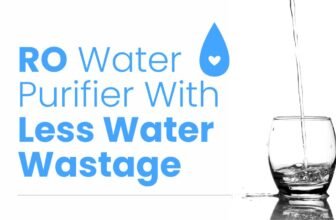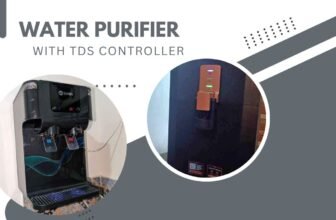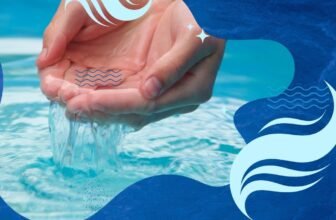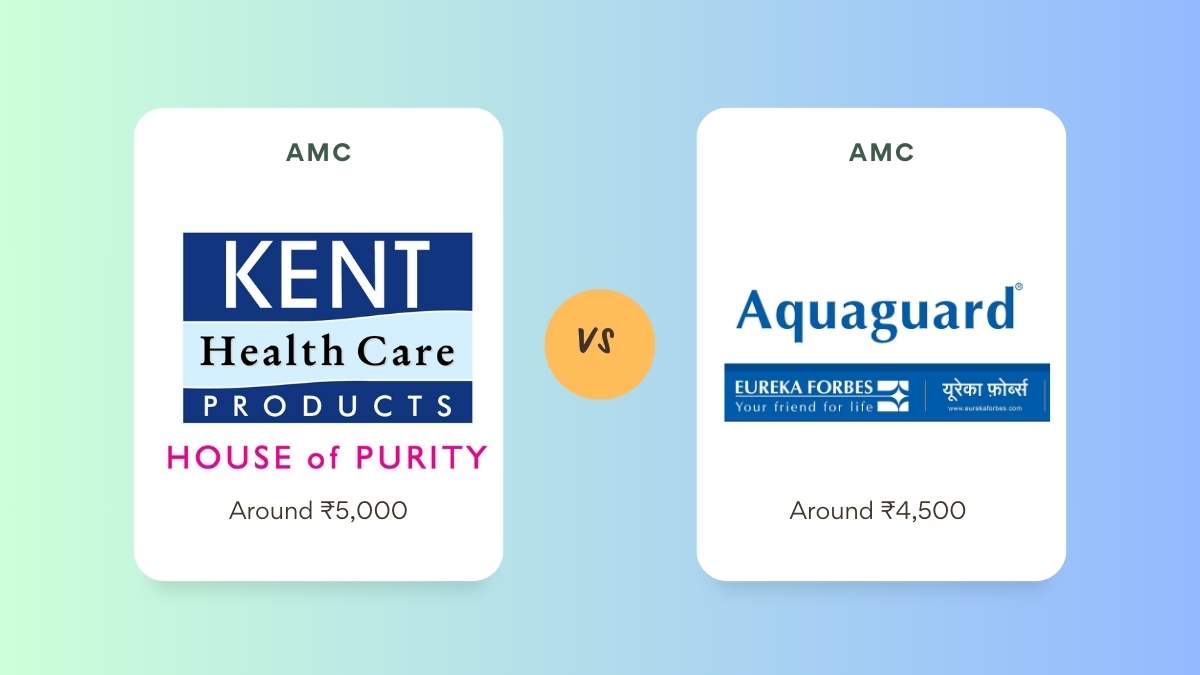
The water purifier market is ruled by two giants—Kent and Aquaguard—each with their own maintenance approach and pricing. While the initial cost may seem similar, the real story unfolds in the annual maintenance cost which can vary drastically between these two and ultimately affect your long term investment.
Thinking of an AMC for your Kent or Aquaguard? What matters more—cheap service or reliable maintenance? Expert technicians, genuine parts, and hassle-free repairs make all the difference. In this blog, I’ll compare annual costs so you can invest in peace of mind!
Kent Vs Aquaguard RO AMC plans – at a glance
Both brands agree that maintenance is key to water purification performance and customer satisfaction.
Kent charges around
₹5,200-6,800
per year for full maintenance.
This includes all filter replacements, membrane servicing, UV lamp changes and 2 technician visits. Kent’s Annual Maintenance Contract (AMC) comes with a water quality guarantee, where TDS levels will be within the specified range throughout the service period.
Aquaguard charges around
₹4,800-5,500
per year for full maintenance.
Aquaguard has a more structured approach with 2 plans: Essential Plan at ₹4,800 per year includes all components and 2 technician visits and Premium Plan at ₹5,500 per year includes unlimited service visits and all component replacements. Aquaguard’s strength lies in their large service network and quick response time in tier-2 and tier-3 cities.
Kent RO doesn’t offer a 12,000 L filter life, but Aquaguard has many models that offer a 2-year comprehensive warranty and an RO filter life of around 12,000 L when TDS is below 1,000 ppm.
These are the list of some of the low maintenance cost RO Water Purifiers
Lifespan of Water Purifier Components
Maintenance goes beyond just replacing filters, it’s membrane servicing, UV lamp changes and system sanitization. Industry standards recommend full maintenance every 6-12 months, depending on water quality and usage. Regular maintenance ensures optimal performance and prevents costly repairs and extends the life of the purifier.
| Component | Replacement Frequency | Average Cost Range | Impact on Performance |
| Pre-filters | 3-6 months | ₹300-800 | Medium |
| RO Membrane | 12-24 months | ₹2,200-2,800 | High |
| UV Lamp | 12 months | ₹800-1,500 | High |
| Post Carbon Filter | 6-12 months | ₹400-900 | Medium |
| TDS Controller | 24-36 months | ₹600-1,200 | Low |
The balance between maintenance cost and water quality cannot be overstated—investing in proper maintenance ensures your family receives consistently pure water while protecting your initial investment in the purifier.
Key Factors Affecting Annual Maintenance Costs
1. Service Network Coverage
Kent has 700+ service centers across India, more in metro cities and urban areas. Technicians are trained on Kent’s proprietary technologies. However, this specialization results in higher service charges in remote areas.
Aquaguard has India’s largest water purifier service network with 2,000+ service points, including rural coverage that Kent can’t match. Their wide presence means competitive pricing and faster response times, especially for customers in smaller cities.
2. Component Quality and Availability
Kent uses imported components for critical parts like RO membranes and UV lamps, which ensures better performance but higher replacement costs. Their filters are designed for longer life—20% more than industry average.
Aquaguard focuses on cost effective solutions with locally sourced components that meet quality standards at competitive prices. Their component availability is excellent due to established supply chain across India.
3. Technology Integration
Kent has IoT based monitoring system that tracks filter life and water quality in real time. This reduces unnecessary service calls but requires specialized technical support, adding to service cost.
Aquaguard uses traditional monitoring method with manual tracking, keeps technology cost low and reliability through proven maintenance protocols.
| Feature | Kent | Aquaguard |
| Annual Cost Range | ₹5,200-6,800 | ₹4,800-5,500 |
| Service Visits Included | 2 scheduled + emergency | 2-unlimited (plan dependent) |
| Component Warranty | 12 months | 6-12 months |
| Remote Area Coverage | Limited | Extensive |
| Response Time | 24-48 hours | 12-24 hours |
| Water Quality Guarantee | Yes | Limited |
| Digital Monitoring | Advanced IoT | Basic tracking |
Service Process Comparison
Kent
- Appointment scheduling through mobile app or customer care
- Technician conducts comprehensive water quality testing before service
- Digital service report with filter life tracking and water quality metrics
Aquaguard
- Easy appointment booking via website, app or phone call
- Focus on rapid component replacement and system sanitization
- Traditional service documentation with component replacement history
The difference is in Kent’s technology driven approach vs Aquaguard’s personal service model.
Detailed Cost Breakdown: Component Replacements
Pre-Filter Costs
Kent pre-filters are ₹450-750 each and you need 2-3 units in a year which is ₹900-2,250. These filters have advanced sediment removal technology that extends downstream component life.
Aquaguard pre-filters are ₹300-550 each and you need 3-4 units in a year which is ₹900-2,200. Their volume purchasing power keeps component costs competitive and filtration performance adequate.
| Component Type | Kent Annual Cost | Aquaguard Annual Cost |
| Pre-filters | ₹900-2,250 | ₹900-2,200 |
| RO Membrane | ₹1,800-2,500 | ₹1,200-2,000 |
| UV Lamp | ₹1,200-1,500 | ₹800-1,200 |
| Post Carbon | ₹600-900 | ₹400-700 |
Professional Service Charges
Kent charges ₹800-1,200 per service visit, because their technicians are trained and their diagnostic procedures are comprehensive. Think of it like choosing between a general mechanic and a BMW certified technician—both can fix your car but one offers specialized expertise for a premium.
Aquaguard service visits cost ₹500-800, because their technicians are trained for speed and coverage not in-depth diagnostics.
Long-term Value Analysis
Efficiency and Performance Impact
Kent’s maintenance approach is long term efficiency, their premium components last 15-20% longer than standard ones. I have seen Kent systems maintaining water quality even when filters are about to be replaced, that’s how good their components are.
Aquaguard focuses on performance at competitive cost. Their maintenance model ensures water quality through more frequent but cost effective component replacements.
Hidden Costs and Additional Charges
Kent’s AMC covers most scenarios but specialized repairs outside normal wear and tear can cost ₹1,500-3,000 extra. Which means unexpected electrical component failures might not be fully covered.
Aquaguard’s transparent pricing model has fewer surprise charges, most repairs are covered under their standard plans. But premium components or system upgrades require separate payment.
Operational Cost Considerations
Water Wastage and Efficiency
Kent systems waste 1:1 to 1:2 ratio (pure to waste water) that’s moderate operational cost. Their advanced recovery technology reduces water wastage compared to conventional RO systems.
Aquaguard systems show similar efficiency ratings, some models achieve 1:1.5 ratio. The difference in water bills is ₹200-400 per year for average households.
Energy Consumption Patterns
Kent purifiers consume 35-50 watts during operation, smart sensors reduce standby power consumption. Annual electricity cost is ₹800-1,200 depending on usage.
Aquaguard systems consume similar power (40-55 watts) but lacks advanced power management in base models. Annual electricity cost is ₹900-1,400 for similar usage.
Service Quality and Customer Satisfaction
Response Time Analysis
I have tracked service response times across both brands over multiple service cycles. Kent takes 36 hours for non-emergency services in metro cities and 48-72 hours in smaller towns.
Aquaguard delivers faster response times—18-24 hours across most locations due to their large service network. If speed of service is important to you, Aquaguard is the clear winner.
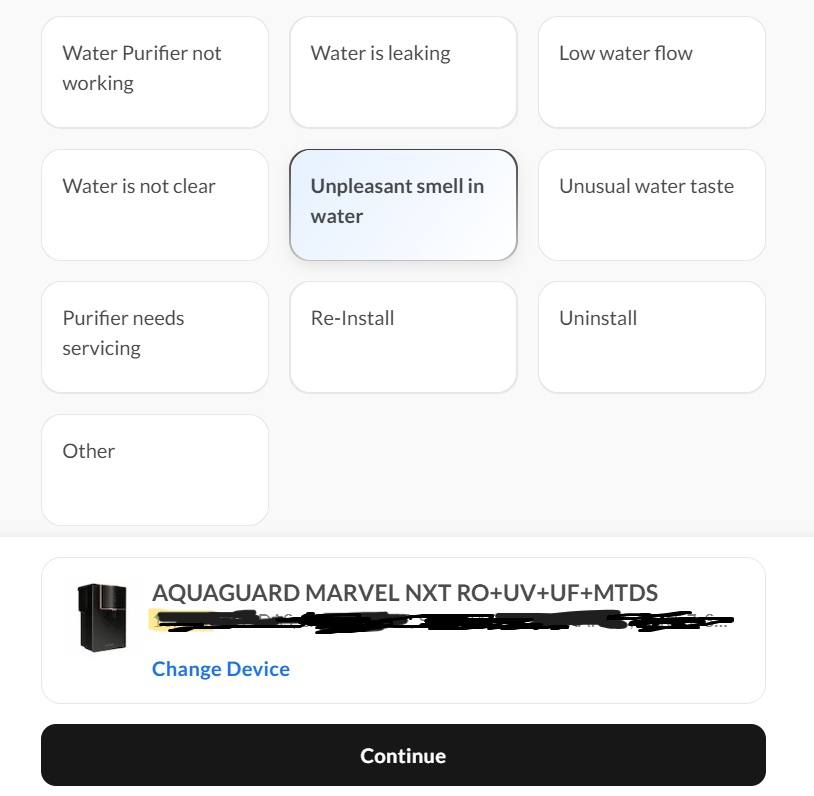
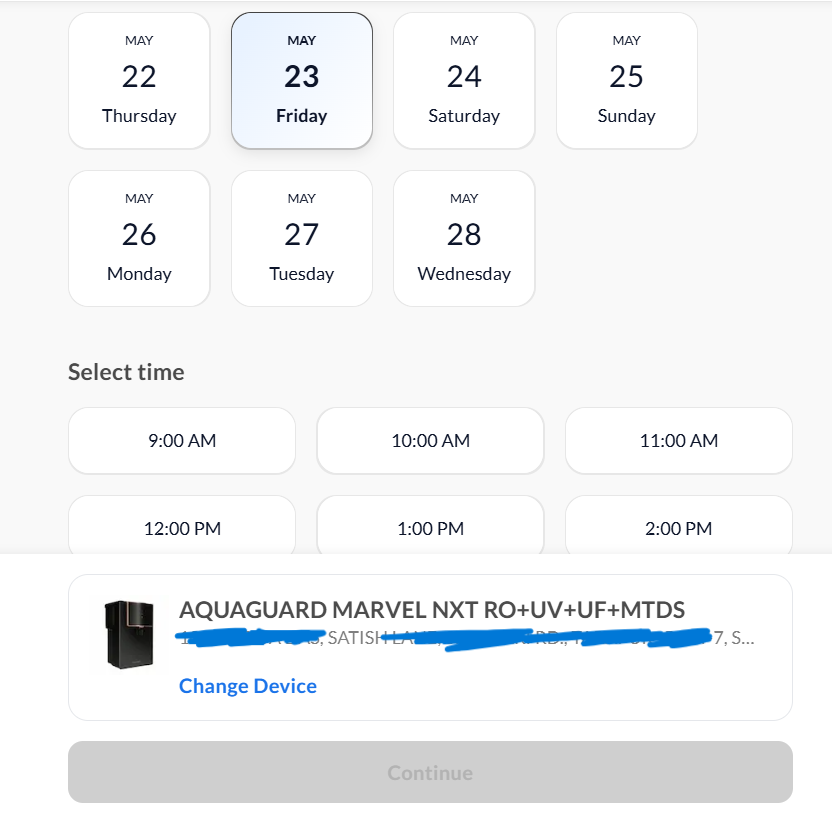
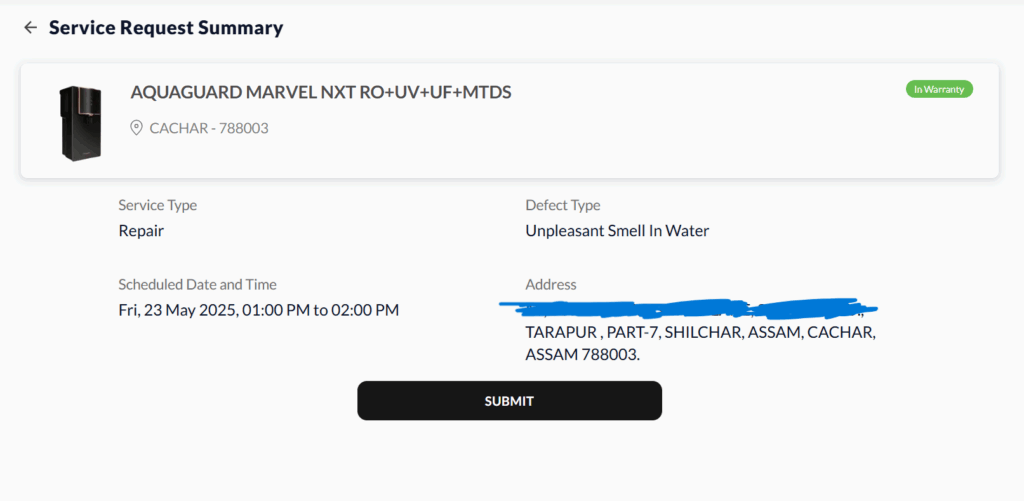
Technician Expertise Levels
Kent technicians are trained on brand specific technologies so they do more thorough diagnostics and targeted solutions. But this specialization sometimes means longer service times and higher costs.
Aquaguard technicians are trained for efficiency and broad compatibility so they are good for routine maintenance but may not be as good for complex troubleshooting.
Regional Cost Variations
Metro vs Tier-2 City Pricing
Kent has same pricing across metro cities but charges 15-25% more in smaller cities due to limited service center coverage. This is because they focus on urban markets.
Aquaguard has more consistent pricing across regions with minimal variation between metro and tier-2 cities. Their large service network gives them economies of scale which benefits customers in smaller markets.
Seasonal Demand Impact
Both brands have peak demand during summer months but Kent’s limited service capacity sometimes results in delayed appointments and ₹200-500 rush charges.
Aquaguard’s large service network can handle seasonal demand spikes and maintains consistent pricing and service quality throughout the year.
Conclusion
Choosing between Kent and Aquaguard is more than just comparing annual maintenance costs—it’s about matching service philosophy with your needs and expectations.
Kent excels in technology integration, component quality and comprehensive water quality assurance so they charge premium for that. Their maintenance model is for tech savvy customers who want advanced features and don’t mind paying extra for specialized service.
Aquaguard dominates in service accessibility, competitive pricing and reliable performance across all segments. Their maintenance model is for cost conscious families who want reliable service without premium features.
If you want latest technology, comprehensive water quality monitoring and don’t mind premium pricing then Kent’s maintenance services are good value for money despite higher costs. But if you want widespread service availability, competitive pricing and proven performance then Aquaguard’s maintenance services are the way to go.






